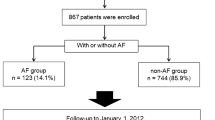Abstract
Background
Although generally recommended for atrial fibrillation (AF) in the general population, the efficacy and safety of warfarin in hemodialysis patients remains controversial. Warfarin use in hemodialysis patients may confer an additional risk of bleeding that is not appreciated in patients without renal failure because hemodialysis patients have platelet defects and receive anticoagulation agents during dialysis. The incidence of major bleeding was reported to be higher in Japanese AF patients on warfarin therapy compared to patients in other countries, suggesting that racial differences may influence bleeding tendency. Thus, examining risks and benefits of warfarin therapy in Japanese hemodialysis patients with AF is important.
Methods
In order to determine associations between warfarin use and new ischemic stroke events, major bleeding, and all-cause mortality, a prospective cohort study of 60 Japanese hemodialysis patients with chronic sustained AF was conducted using Cox proportional modeling and propensity score matching.
Results
The mean patient age was 68.1 years. During 110 person-years of follow-up, 13 ischemic strokes occurred. After adjusting for CHADS2 score, warfarin use was not associated with a significant reduction in ischemic stroke events [hazard ratio (HR) 3.36; 95 % confidence interval (CI) 0.94–11.23]. Similar results were obtained after propensity score matching (HR 3.36; 95 % CI 0.67–16.66). Warfarin use was not associated with significant increases in major bleeding or all-cause mortality.
Conclusions
These results suggest that warfarin may not prevent ischemic stroke in Japanese hemodialysis patients with chronic sustained AF. Adequately powered studies are needed to determine the risks and benefits of anticoagulation therapy in these patients.


Similar content being viewed by others
References
Wakasugi M, Kazama JJ, Yamamoto, Kawamura K, Narita I. Cause-specific excess mortality among dialysis patients: comparison with the general population in Japan. Ther Apher Dial. Article first published online: 11 Dec 2012. doi:10.1111/j.1744-9987.2012.01144.x.
Wizemann V, Tong L, Satayathum S, Disney A, Akiba T, Fissell RB, et al. Atrial fibrillation in hemodialysis patients: clinical features and associations with anticoagulant therapy. Kidney Int. 2010;77:1098–106.
Gage BF, Waterman AD, Shannon W, Boechler M, Rich MW, Radford MJ. Validation of clinical classification schemes for predicting stroke: results from the National Registry of Atrial Fibrillation. JAMA. 2001;285:2864–70.
Zimmerman D, Sood MM, Rigatto C, Holden RM, Hiremath S, Clase CM. Systematic review and meta-analysis of incidence, prevalence and outcomes of atrial fibrillation in patients on dialysis. Nephrol Dial Transplant. 2012;27:3816–22.
Ogawa S, Aizawa Y, Atarashi H, Inoue H, Okumura K, Kamakura S, et al. Guidelines for pharmacotherapy of atrial fibrillation. Circ J. 2008;72(Suppl. IV):1639–58 (in Japanese).
Hart RG, Pearce LA, Aguilar MI. Meta-analysis: antithrombotic therapy to prevent stroke in patients who have nonvalvular atrial fibrillation. Ann Intern Med. 2007;146:857–67.
Wiesholzer M, Harm F, Tomasec G, Barbieri G, Putz D, Balcke P. Incidence of stroke among chronic hemodialysis patients with nonrheumatic atrial fibrillation. Am J Nephrol. 2001;21:35–9.
Chan KE, Lazarus JM, Thadhani R, Hakim RM. Warfarin use associates with increased risk for stroke in hemodialysis patients with atrial fibrillation. J Am Soc Nephrol. 2009;20:2223–33.
Lai HM, Aronow WS, Kalen P, Adapa S, Patel K, Goel A, et al. Incidence of thromboembolic stroke and of major bleeding in patients with atrial fibrillation and chronic kidney disease treated with and without warfarin. Int J Nephrol Renovasc Dis. 2009;2:33–7.
Winkelmayer WC, Liu J, Setoguchi S, Choudhry NK. Effectiveness and safety of warfarin initiation in older hemodialysis patients with incident atrial fibrillation. Clin J Am Soc Nephrol. 2011;6:2662–8.
Olesen JB, Lip GY, Kamper AL, Hommel K, Køber L, Lane DA, et al. Stroke and bleeding in atrial fibrillation with chronic kidney disease. N Engl J Med. 2012;367:625–35.
Suzuki S, Yamashita T, Kato T, Fujino T, Sagara K, Sawada H, et al. Incidence of major bleeding complication of warfarin therapy in Japanese patients with atrial fibrillation. Circ J. 2007;71:761–5.
Johnson JA. Warfarin: an old drug but still interesting. Pharmacotherapy. 2008;28:1081–3.
Nakai S, Iseki K, Itami N, Ogata S, Kazama JJ, Kimata N, et al. An overview of regular dialysis treatment in Japan (as of 31 December 2010). Ther Apher Dial. 2012;16:483–521.
Daugirdas JT. Second generation logarithmic estimates of single-pool variable volume Kt/V: an analysis of error. J Am Soc Nephrol. 1993;4:1205–13.
Cepeda MS, Boston R, Farrar JT, Strom BL. Comparison of logistic regression versus propensity score when the number of events is low and there are multiple confounders. Am J Epidemiol. 2003;158:280–7.
D’Agostino RB Jr. Propensity score methods for bias reduction in the comparison of a treatment to a non-randomized control group. Stat Med. 1998;17:2265–81.
Clase CM, Holden RM, Sood MM, Rigatto C, Moist LM, Thomson BK, et al. Should patients with advanced chronic kidney disease and atrial fibrillation receive chronic anticoagulation? Nephrol Dial Transplant. 2012;27:3719–24.
Conflict of interest
The authors have declared that no conflict of interest exists.
Author information
Authors and Affiliations
Corresponding author
About this article
Cite this article
Wakasugi, M., Kazama, J.J., Tokumoto, A. et al. Association between warfarin use and incidence of ischemic stroke in Japanese hemodialysis patients with chronic sustained atrial fibrillation: a prospective cohort study. Clin Exp Nephrol 18, 662–669 (2014). https://doi.org/10.1007/s10157-013-0885-6
Received:
Accepted:
Published:
Issue Date:
DOI: https://doi.org/10.1007/s10157-013-0885-6




